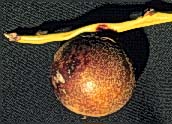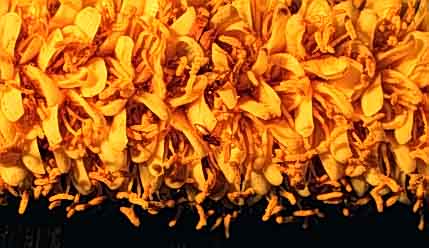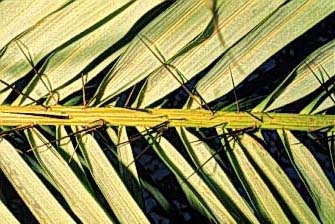
Acrocomia aculeata (Jacq.) Lodd. ex Mart.
(Arecaceae)
 |
Acrocomia aculeata (Jacq.) Lodd. ex Mart.
(Arecaceae) | |
Espinoza, R., Guadamuz, A., Perez, D., Chavarría, F. and Masís, A. 1998. Acrocomia aculeata (Arecaceae) Species Page , June 30, 1998 . Species Home Pages, Area de Conservación Guanacaste, Costa Rica. http://www.acguanacaste.ac.cr
Palm 4-10 m tall, with a thick trunk and many thorns.
Flower:
The inflorescence is a axillary raceme of yellow, small, perfect (both sexes on the same flower), flowers and with a sweet aroma.
 | |
Inflorescence | |
Fruit:
The fruit is round, approximately 3.5 cm in diameter. Green what immature and brown when mature. Glabrous.
|
Whole fruit |
Leaves:
Compound pinnate foliar lamina 2-3.5 m long (Grayum, 1997).
|
Upper surface of the leaf |
Under surface of the leaf |
Hoja entera |
 | ||
Under surface of the leaf showing the thorns on the rachis | ||
Bark and wood:
Stems with cilindrical thorns, 5-10 cm long.
|
Stem or trunk with thorns |
Whole plant architecture:
Palm 4-10 m tall, with thick trunk and many thorns.
General aspect of the plant | |
Similar species:
Verification:
Identification, R. Espinoza.
II.Geographic distribution:
International:
México to Argentina, Bolivia and Paraguay ( Henderson et.al. 1998).
In Costa Rica:
Lowland zones of the Atlantic and Pacific watersheds.
In the Area de Conservación Guanacaste:
Lowland zones of both the Atlantic and Pacific watersheds. In old pastures and second growth regions in various states of regeneration.
Map of macro-habitats of the ACG |
III. Natural History:
Dispersada por ganado. Se piensa que es un fruto de la megafauna del pleistoceno y probablemente desaparesca del bosque secundario ya que no hay ningún animal en el bosque que la disperse.
IV. How to find:
Es muy común en potreros donde hay ganado y en potreros y tacotales viejos dentro del ACG.
Acknowledgments.
This project was carried out by the Area de Conservación Guanacaste/CR, with help from INBio/CR, ICBG from the Foggarty center, NIH/USA and NSF/USA.
Literature cited: